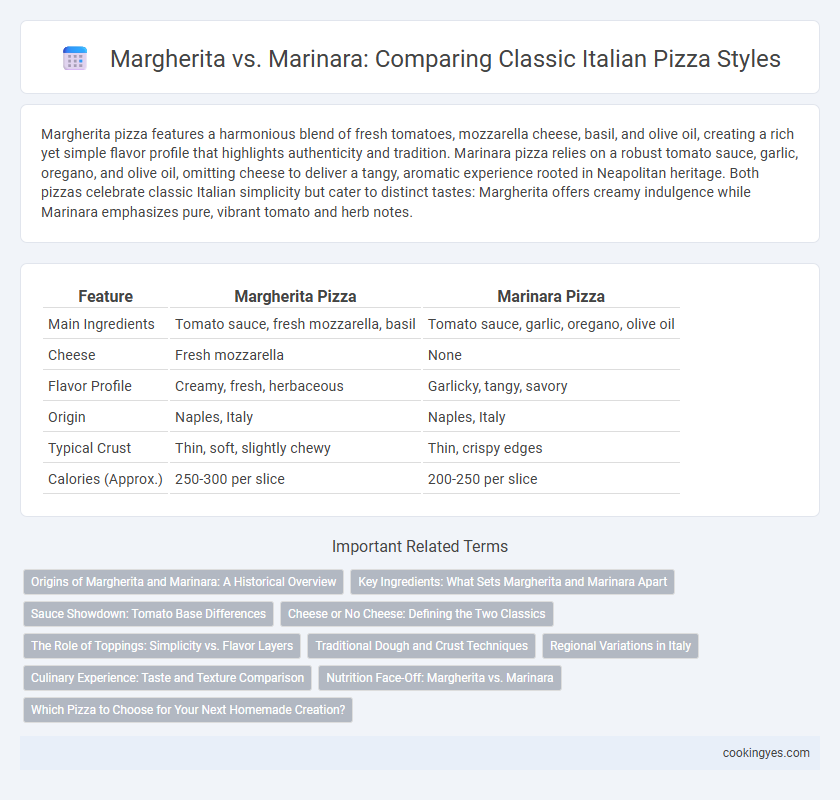Margherita pizza features a harmonious blend of fresh tomatoes, mozzarella cheese, basil, and olive oil, creating a rich yet simple flavor profile that highlights authenticity and tradition. Marinara pizza relies on a robust tomato sauce, garlic, oregano, and olive oil, omitting cheese to deliver a tangy, aromatic experience rooted in Neapolitan heritage. Both pizzas celebrate classic Italian simplicity but cater to distinct tastes: Margherita offers creamy indulgence while Marinara emphasizes pure, vibrant tomato and herb notes.
Table of Comparison
| Feature | Margherita Pizza | Marinara Pizza |
|---|---|---|
| Main Ingredients | Tomato sauce, fresh mozzarella, basil | Tomato sauce, garlic, oregano, olive oil |
| Cheese | Fresh mozzarella | None |
| Flavor Profile | Creamy, fresh, herbaceous | Garlicky, tangy, savory |
| Origin | Naples, Italy | Naples, Italy |
| Typical Crust | Thin, soft, slightly chewy | Thin, crispy edges |
| Calories (Approx.) | 250-300 per slice | 200-250 per slice |
Origins of Margherita and Marinara: A Historical Overview
Margherita pizza originated in Naples in 1889, created to honor Queen Margherita of Savoy with its ingredients representing the Italian flag: basil, mozzarella, and tomato. Marinara pizza, dating back to the late 18th century, was named after the seamen ("marinai") who favored its simple toppings of tomato, garlic, oregano, and olive oil for a quick, flavorful meal. Both pizzas reflect Naples' rich culinary heritage and use fresh, locally sourced ingredients integral to traditional Italian cuisine.
Key Ingredients: What Sets Margherita and Marinara Apart
Margherita pizza features fresh mozzarella, ripe tomatoes, and fragrant basil leaves, creating a creamy and aromatic profile that highlights the use of dairy and herbs. Marinara relies on a simpler combination of tomato sauce, garlic, oregano, and olive oil, emphasizing robust, savory flavors without any cheese. The distinct use of mozzarella in Margherita versus the garlic and oregano in Marinara defines their key ingredient differences and flavor identities.
Sauce Showdown: Tomato Base Differences
Margherita pizza features a rich tomato sauce made from fresh, slightly sweet San Marzano tomatoes, balanced with basil and mozzarella, creating a creamy, savory flavor. Marinara sauce relies on a simpler, tangier blend of crushed tomatoes, garlic, oregano, and olive oil, offering a zesty, herb-forward profile without cheese. The tomato base in Margherita emphasizes smoothness and subtle sweetness, while Marinara highlights bright acidity and robust herbal notes, defining their distinctive classic tastes.
Cheese or No Cheese: Defining the Two Classics
Margherita pizza is defined by its use of fresh mozzarella cheese, basil, and tomato sauce, creating a rich, creamy texture that highlights the cheese's essential role in classic Neapolitan pizza. In contrast, Marinara pizza excludes cheese entirely, relying on a robust combination of tomato sauce, garlic, oregano, and olive oil for its bold, tangy flavor profile. The presence or absence of cheese distinguishes these two iconic styles, with Margherita offering a milder, creamier taste and Marinara delivering a simpler, more intensely savory experience.
The Role of Toppings: Simplicity vs. Flavor Layers
Margherita pizza features a balanced combination of fresh mozzarella, basil, and tomato sauce, emphasizing simplicity while delivering rich flavor layers through quality ingredients. Marinara pizza relies on a straightforward blend of tomato, garlic, oregano, and olive oil, showcasing bold, unadorned flavors that highlight traditional Italian culinary roots. The role of toppings in these classic styles defines their distinct appeal: Margherita offers a harmonious taste profile with creamy and herbal notes, whereas Marinara presents an intense, aromatic experience through minimal but impactful ingredients.
Traditional Dough and Crust Techniques
Traditional dough and crust techniques distinguish Margherita and Marinara pizzas through their specific preparation methods. Margherita dough typically undergoes a slow fermentation process, resulting in a soft, airy crust that complements fresh mozzarella, basil, and tomato toppings. Marinara dough, while similar in base ingredients, often features a slightly thinner, crispier crust that enhances the flavors of garlic, oregano, and tomato sauce in this classic Neapolitan style.
Regional Variations in Italy
Margherita pizza, originating from Naples, features a balanced combination of tomato, mozzarella, and basil symbolizing the Italian flag, and is beloved nationwide but especially in Campania. Marinara pizza, also rooted in Naples, is simpler with tomato, garlic, oregano, and olive oil, epitomizing traditional and coastal flavors popular in Southern Italy. Regional variations see Margherita sometimes topped with buffalo mozzarella in Campania, while Marinara remains a staple in Liguria and coastal regions where seafood influences occasionally infuse the sauce.
Culinary Experience: Taste and Texture Comparison
Margherita pizza offers a rich culinary experience with its harmonious blend of fresh mozzarella, sweet basil, and tangy tomato sauce creating a creamy and aromatic texture. Marinara pizza delivers a vibrant, garlicky taste with a crispier, chewier crust accentuated by robust tomato sauce, oregano, and fresh garlic, providing a lighter, more intense flavor profile. Both classic styles highlight the freshness of ingredients, but Margherita emphasizes creaminess and balance, while Marinara focuses on simplicity and bold, savory notes.
Nutrition Face-Off: Margherita vs. Marinara
Margherita pizza, featuring fresh mozzarella, tomatoes, and basil, provides a balanced source of protein, calcium, and antioxidants, while Marinara pizza, made with tomato sauce, garlic, oregano, and olive oil, offers a lower calorie option rich in vitamins A and C and heart-healthy fats. The Margherita's cheese increases calcium and protein content, making it more satiating, whereas Marinara's absence of cheese reduces saturated fat and total calories. Choosing between these classic pizzas depends on individual nutritional goals, with Margherita supporting muscle maintenance and Marinara favoring a lighter, antioxidant-rich diet.
Which Pizza to Choose for Your Next Homemade Creation?
Margherita pizza combines fresh mozzarella, basil, and tomato sauce, offering a balanced flavor profile ideal for those who prefer a creamy and herbaceous experience. Marinara pizza, topped with tomato, garlic, oregano, and olive oil, suits fans of a bold, tangy, and garlic-forward taste without cheese. Choosing between Margherita and Marinara depends on whether you seek a cheesy, aromatic classic or a simple, robustly savory pie for your homemade creation.
Margherita vs Marinara for classic pizza styles Infographic

 cookingyes.com
cookingyes.com